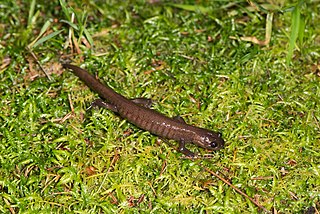
Hynobius arisanensis, the Alishan salamander, is a species of salamander in the family Hynobiidae endemic to Taiwan. It occurs in the Alishan Range, the Yushan Range, and southern Central Mountain Range, where it lives at altitudes of 1,800–3,600 m (5,900–11,800 ft) above sea level. Its natural habitats are temperate forests, rivers, and freshwater springs. It is usually hiding during day time.

The Odaigahara salamander is a species of salamander in the family Hynobiidae. It is endemic to Japan. Its natural habitats are temperate forests, rivers, and freshwater springs. This species is threatened by habitat loss.
The Chinese salamander is a species of salamander in the family Hynobiidae endemic to China. Its natural habitats are subtropical or tropical moist lowland forests, rivers, freshwater marshes, freshwater springs, and arable land. It is threatened by habitat loss.

The Oita salamander is a species of salamander in the family Hynobiidae endemic to Japan. Named after Oita Prefecture, its natural habitats are temperate forests, rivers, intermittent rivers, freshwater marshes, intermittent freshwater marshes, and irrigated land in western Japan. It is threatened by habitat loss, due to the increasing construction of homes within its habitat. The Oita Salamander is considered to be vulnerable by the (IUCN) Red List of Threatened Species with a declining population.
Hynobius guabangshanensis is a species of salamander in the family Hynobiidae, endemic to China, as it is only known from the locality from where it was described as a new species to science in 2004, at Guabang Shan Tree Farm in Qiyang County of Hunan Province. Its natural habitats are temperate shrubland, swamps, freshwater marshes, and seasonally flooded agricultural land.
The Hakuba salamander or Japanese mountain salamander is a species of salamander in the family Hynobiidae. This salamander is also synonymous with the mountain salamander. It is endemic to Japan. Its natural habitats are temperate forests, rivers, swamps, freshwater springs, and plantations. It is threatened by habitat loss.
Hynobius katoi is a species of salamander in the family Hynobiidae, endemic to Japan. Its natural habitats are temperate forests and rivers.

The Hida salamander or Hondo salamander is a species of salamander in the family Hynobiidae, the Asiatic salamanders. It is endemic to central and western Honshu, Japan. It lives in deciduous, coniferous, and mixed forests, where it breeds in streams. The egg sacs of this species were reported to display blue-to-yellow iridescent glow due to a quasi-periodic diffraction grating structure embedded within the enveloppes of the egg sacs. These salamanders typically spawn from February to April, leading some to metamorphose in late September while others wait for the following year to do so after winter is over.

The Tohoku salamander is a species of salamander in the family Hynobiidae, endemic to Japan. Its natural habitats are temperate forests and rivers.
Hynobius naevius, also known as the spotted salamander, Sagami salamander, Japanese salamander, and blotched salamander, is a species of salamander in the family Hynobiidae. It is endemic to northwestern Kyushu, Japan. Earlier records from Honshu represent other species.

Hynobius nebulosus, the Mitsjama salamander, is a species of salamander in the family Hynobiidae endemic to Japan. Its natural habitats are temperate forests, rivers, swamps, freshwater springs, and irrigated land. It is threatened by habitat loss.
The Oki salamander is a species of salamander in the family Hynobiidae, endemic to Japan. Its natural habitats are temperate forests, rivers, and plantations. It is threatened by habitat loss.

The Ezo salamander or Hokkaido salamander is a species of salamander in the family Hynobiidae, endemic to Japan. Its natural habitats are temperate forests, temperate shrubland, swamps, freshwater marshes, intermittent freshwater marshes, freshwater springs, irrigated land, and canals and ditches.
The amber salamander, amber-colored salamander, tortoiseshell salamander, or Stejneger's oriental salamander is a species of salamander in the family Hynobiidae, endemic to Japan. Its natural habitats are temperate forests and rivers. It is threatened by habitat loss.
The Hokuriku salamander is a species of salamander in the family Hynobiidae, endemic to Japan. Its natural habitats are temperate forests, rivers, freshwater marshes, freshwater springs, and irrigated land. It is threatened by habitat loss.

The Tokyo salamander is a species of salamander in the family Hynobiidae, endemic to Japan. Its natural habitats are temperate forests, freshwater springs, arable land, irrigated land, and canals and ditches. It is threatened by habitat loss. Many different species of amphibian have unbalanced sex ratios. This trend is no different in Hynobius Tokyoensis; the sex ratio between males and females is about 1.5:1. Although this does not play as large of a role as habitat destruction when it comes to the decline of this species, it is still significant. Considering their environmental preferences, they are usually found in paddy fields. Mid-Summer drainage from these fields hinders the population's ability to thrive as this would occur before these populations could complete metamorphosis.
The Tsushima salamander is a species of salamander in the family Hynobiidae, endemic to Japan. Its natural habitats are temperate forests and rivers.
Hynobius yiwuensis, the Yiwu salamander, is a species of salamander in the family Hynobiidae, endemic to Zhejiang, China. Its distribution area is central and eastern Zhejiang, and includes Yiwu that has given it its name. Its natural habitats are subtropical moist lowland forests, rivers, freshwater marshes, intermittent freshwater marshes, arable land, and rural gardens. The Yiwu salamander is threatened by habitat loss.
The Xingan salamander is a species of salamander in the family Hynobiidae, endemic to China: it is only known from its type locality, Mao'ershan in the Xing'an County, Guangxi. Its natural habitats are marshes and the surrounding forests. It is threatened by habitat loss and, living close to the summit of Mao'ershan at around 2,000 m (6,600 ft) asl, by climate change. It occurs within the Mao'ershan National Nature Reserve.









